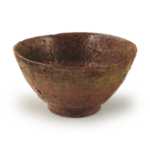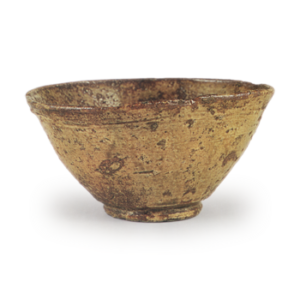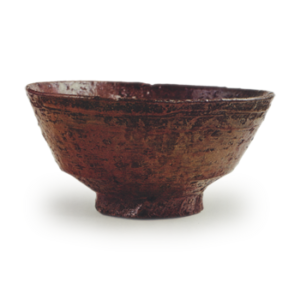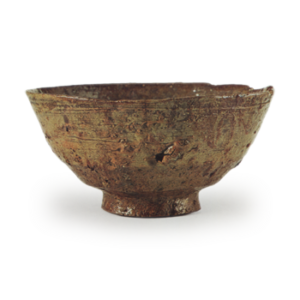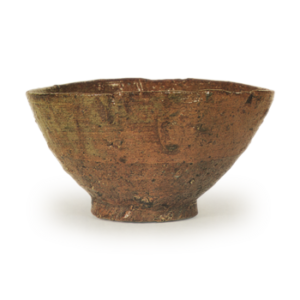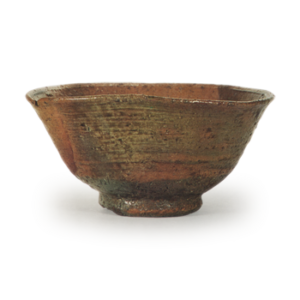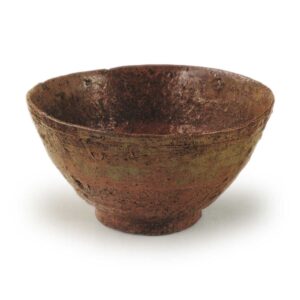
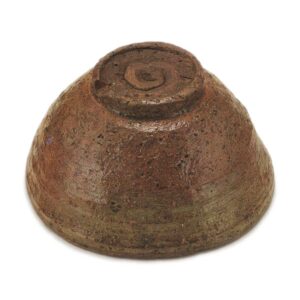
Height: 7.4-7.8cm
Diameter: 13.8-4.6cm
Height of foot ring: 6.0cm
Height of rim: 1.0cm
In recent years, the three most highly regarded Iroha tea bowls are called “Autumn Mountain”, “Autumn in Saga” and “Ryohiko”, but it is a shame that “Autumn in Saga” was not included in this volume. However, this tea bowl also surpasses the others in the depth of its nail-carved foot, and it is probably the best of all the nail-carved foots that I have seen. Perhaps it was because of the beauty of this foot that Fumai-dono loved this tea bowl so much.
The date of production of the Iroha tea bowls, including the kugibori, is thought to be after the Bunroku-Keicho War, that is, from the late Momoyama period to the early Edo period, but some people think that the kugibori is seen as belonging to the oldest works, and it may be that this theory is correct, as the kugibori has a strong sense of power, in contrast to the elegant works of katamigawari-te and kiiro-irabo.
The foot ring, which has been carefully carved out, is relatively large, and the fact that it has been incised with a spatula on one side is clearly the result of deliberate design, and this is probably a reflection of the preferences of the tea master.
The whorl-shaped nail carving inside the foot ring has been slowly and roughly carved, further enhancing the overall sense of weightiness of the foot ring. The rim is slightly deeper, and the foot of the bowl rises up sharply, giving it a knotty appearance.
The bowl rises up slowly from the waist to the rim, giving it a somewhat heavy appearance, but it also gives the impression of a vastness of its own. The diagonal scrape marks from the waist to the foot of the bowl are rather rough, and the clay surface is also rough, with traces of small stones. From the waist upwards, the fine lathe marks are particularly noticeable around the rim.
The inside of the bowl is wide and spacious, and the brown tea stains that run around the rim give it a sense of depth. There are four bevel marks on the rim, which are said to be a sign of Iraho, and although the marks where the foot was attached are almost completely indistinct, there are four or five faint marks on the inside of the bowl.
The glaze is thin overall, and the lower half of the exterior is reddish, while the upper half has a thick, thin, mottled light green glaze. The reddish color also changes to orange in some places and to a dark reddish brown in others, and the thick blue glaze is clearly visible around the rim.
The inside is generally reddish, and a light green glaze appears in patches near the rim, but the reddish coloration from the center of the inside to the waist is particularly vivid.
There are small stones, pits, and cracks on the inside and outside, giving it the irritable texture unique to Iraho ware. However, the glaze is a little more subdued than other pieces, and the highlight of this tea bowl is the beauty of the nail-carved foot ring.
This tea bowl was formerly owned by Matsudaira Fumai, and on the lid of the paulownia wood box it is inscribed in silver powder letters with the three characters “Irobo” in the handwriting of the same lord. However, this name does not appear in the “Unshu Meibutsu Ki” (Famous Things of Unshu), and incidentally, the only two Irobo tea bowls with nail-engraved designs listed in the same book are “Hatsusou” and “Yamabuki”.

